Watch out, Bud!: What Happens if a Tree Buds Too Early?
Caring for plants is a difficult process, and trees are no exception. While you may look at a tree as the sturdier and thus more resilient alternative to a potted plant, the truth is that trees are at a huge risk for much of their life—especially for those that produce fruits or flowers.
Trees, like any other plant, rely on weather patterns to know when and at what rate they are supposed to mature and bloom. When weather patterns are unusual, trees can easily be thrown off their anticipated schedule. Just as you may grow confused when the temperature hits a sudden high or low mark for the season, your plants are going to grow just as confused. The difference is that while a sudden drop in temperature for you may simply mean you’re without the proper jacket for the day, it could leave your tree at dangerous odds for survival—especially if your tree is rather young.
Trees maintain a growth cycle that is designed to have them blooming when the season is right, most typically in the spring. A warm winter can throw that growth cycle off, causing a tree to begin budding in the winter. If the weather stays warm and there are no sudden shifts in temperature, then this may only cause your tree to have an odd but not otherwise unhealthy blooming schedule. The danger comes when a tree buds in the winter and then a cold front moves through, leaving all those buds exposed to freezing temperatures.
It is for this reason that blooming too early can put unnecessary stress on trees. When this happens, any new growth that has developed could become shocked and damaged, potentially causing long-term damage to the tree. This is especially a concern for fruit and flowering trees, of which the buds are most vulnerable.
There is not all too much you can do if a tree begins budding too early, but you can make some interventions in the best interest of your trees. Cutting off buds as they develop will cause the tree to put its energy toward growth within the trunk, helping the tree to become sturdier and thus more likely to survive freezing temperatures and sudden temperature drops. This is an especially helpful tactic with young trees. But if you have already let the buds develop, then the next best thing you can do is try to support survival by covering your tree during hard frost and freeze warnings.
Premier Tree Solutions can help. We specialize in a number of arboreal areas, including tree removal, tree trimming, pruning, storm damage reparation and cleanup, branch clearing and debris removal, stump removal, grinding, Bobcat work and more. If you need tree-related help, give us a shout. Let us know how we can help today at 404-252-6448 or contact us here.







